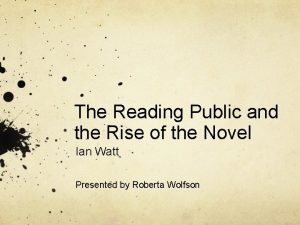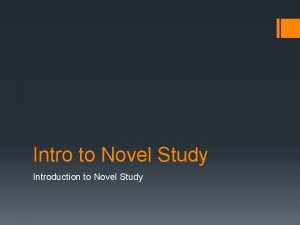The Rise of the Novel Study Questions Millennium



- Slides: 3

The Rise of the Novel Study Questions Millennium I p. 160

1. • 2. • What does the novel’s realism consists of ? Novels deal with recognisably contemporary objects, language and situations. What are the novel’s main features? Its main features are: – – A great stress on contemporary reality; The chronological sequence of events; The abundance in realistic details; The novelty of the stories. 3. What was the novel’s aim? • To represent the ideals of the rising commercial and mercantile middle class, whose attitude to life was mainly practical and realistic, and who demanded original stories about ordinary experiences by ordinary characters. 4. How did the novel reflect middle-class values and virtues? • Defoe’s novels celebrated commercial wisdom and enterprise and the faith in God’s favour, which were distinctive values of the Puritan middle class; while Richardson’s novels praised sobriety, temperance, economy and modesty, also typically bourgeois virtues. Significantly, women were both heroines of novels and avid readers of them. 5. How does modern awareness of time and space show in Defoe’s “Robinson Crusoe”? • Robinsons records his experiences from year to year and often from day to day; his voyages are measured by latitude and longitude and pinpointed by the names of real seas, ships, and harbours. It is because of this form of detailed realism that we are made to accept the improbability of the story.

6. What tradition is Swift’s “Gulliver Travels” indebted to? • It is indebted to the Utopian tradition which presents imaginary worlds as the counterpart of the real imperfect society; 7. What are Richardson’s great innovations in his epistolary novels? • Richardson’s epistolary novels present – exchanges of letters between several correspondents; – psychological analysis and the process of growing up of the protagonist become of great importance together with. . . – a detailed description of interiors. 8. How did Fielding improve on the picaresque pattern in “Tom Jones”? • Fielding’s story is divided into three classically balanced parts: the road, the countryside, London. The protagonist’s adventures are not casual but part of a process of growing up. 9. What are sentimental novels based on? What is the masterpiece in this tradition? • Sentimental novels are based on a type of writing which causes intense emotional reactions. The masterpiece in this tradition is Sterne’s “Sentimental Journey”, which is half a travel diary, half a sentimentalized autobiography. 10. Why is “Tristram Shandy” an unusual novel? • Because it has no conventional plot and time scheme and is characterized by an endless sequence of digressions and flashbacks.





